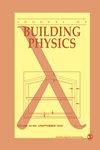不完善砌体界面的湿热建模方法
IF 1.4
4区 工程技术
Q3 CONSTRUCTION & BUILDING TECHNOLOGY
引用次数: 4
摘要
湿热模型是评估与水分相关的腐烂机制风险的重要工具,这些机制可能会损害结构完整性,建筑特征和材料的损失。在砌体建模时,有几个不确定的来源,与材料特性、边界条件、施工质量以及砂浆和单元之间的二维相互作用有关。本文研究了砂浆-单元界面的不确定度,如发际裂纹或不完美的接触条件。这些缺陷将改变液体进出墙体的速率,阻碍砂浆和砌体单元之间的液体输送。这意味着,如果只对散装材料的特性进行建模,那么壁面系统的有效液体输送将是不同的。给出了一种将该界面建模为断裂的详细方法,包括断裂材料特性的定义。该建模方法考虑了砂浆-单元界面上的界面阻力和平行于界面增加的液体输运的综合影响,并可推广到各种材料、几何形状和裂缝孔径的组合。建立了粘土砖/水泥砂浆砌体墙的二维DELPHIN模型来模拟这种相互作用。模型暴露在不同的边界条件下,模拟湿润、干燥和自然循环天气条件。这些模拟结果与不包括裂缝模型的基线模型进行了比较。裂缝的存在增加了润湿阶段的吸附速率和干燥阶段的解吸速率。在循环条件下,降雨事件后的峰值水分含量高于基线,而长时间干燥后的水分含量较低。这表明,砂浆-单元界面缺陷的详细建模可以对湿热模拟的结果和结论产生决定性影响。本文章由计算机程序翻译,如有差异,请以英文原文为准。
A methodology for hygrothermal modelling of imperfect masonry interfaces
Hygrothermal models are important tools for assessing the risk of moisture-related decay mechanisms which can compromise structural integrity, loss of architectural features and material. There are several sources of uncertainty when modelling masonry, related to material properties, boundary conditions, quality of construction and two-dimensional interactions between mortar and unit. This paper examines the uncertainty at the mortar-unit interface with imperfections such as hairline cracks or imperfect contact conditions. These imperfections will alter the rate of liquid transport into and out of the wall and impede the liquid transport between mortar and masonry unit. This means that the effective liquid transport of the wall system will be different then if only properties of the bulk material were modelled. A detailed methodology for modelling this interface as a fracture is presented including definition of material properties for the fracture. The modelling methodology considers the combined effect of both the interface resistance across the mortar-unit interface and increase liquid transport in parallel to the interface, and is generalisable to various combinations of materials, geometries and fracture apertures. Two-dimensional DELPHIN models of a clay brick/cement-mortar masonry wall were created to simulate this interaction. The models were exposed to different boundary conditions to simulate wetting, drying and natural cyclic weather conditions. The results of these simulations were compared to a baseline model where the fracture model was not included. The presence of fractures increased the rate of absorption in the wetting phase and an increased rate of desorption in the drying phase. Under cyclic conditions, the result was higher peak moisture contents after rain events compared to baseline and lower moisture contents after long periods of drying. This demonstrated that detailed modelling of imperfections at the mortar-unit interface can have a definitive influence on results and conclusions from hygrothermal simulations.
求助全文
通过发布文献求助,成功后即可免费获取论文全文。
去求助
来源期刊

Journal of Building Physics
工程技术-结构与建筑技术
CiteScore
5.10
自引率
15.00%
发文量
10
审稿时长
5.3 months
期刊介绍:
Journal of Building Physics (J. Bldg. Phys) is an international, peer-reviewed journal that publishes a high quality research and state of the art “integrated” papers to promote scientifically thorough advancement of all the areas of non-structural performance of a building and particularly in heat, air, moisture transfer.
 求助内容:
求助内容: 应助结果提醒方式:
应助结果提醒方式:


